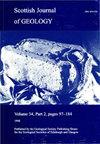苏格兰斯凯岛侏罗纪首次也是最北部出现的地中海鳄形目恐龙
IF 0.5
4区 地球科学
Q4 GEOLOGY
引用次数: 1
摘要
侏罗纪是恐龙、鳄鱼和许多其他脊椎动物进化的关键时期。近年来,苏格兰斯凯岛早-中侏罗纪出现了新的脊椎动物化石;然而,人们对斯凯恐龙区系的了解远多于对其鳄鱼形态的了解。在这里,我们报道了从斯凯东北海岸查理王子洞穴的侏罗纪海洋沉积物中收集到的新鳄鱼化石材料。该标本是一个小鹅卵石,包含一个个体的颅后元素,其大小比之前在斯凯描述的鳄鱼化石大得多。根据脊椎和骨皮的特征,该标本被归类于Thalattosuchia,这是一个已灭绝的半水生/远洋鳄鱼化石分支。具体来说,骨皮动物背表面呈交替排列的亚圆形和豆状的凹坑装饰表明与半水生谱系远龙亚科有亲缘关系。尽管骨皮上的装饰图案与bollensis Macropondylus(“Teneosaurus”)最为相似,但我们保守地将该标本归属于不确定的远龙总科。无论其精确的亲缘关系和零碎的性质如何,该标本都是在苏格兰发现的第一个丘脑类人猿,也是全球报道的侏罗纪丘脑类人猿中最北的一个,这增加了我们对该类群古生物地理学和进化的了解。主题集:本文是早期职业研究集的一部分,可在以下网站获取:https://www.lyellcollection.org/cc/SJG-early-career-research本文章由计算机程序翻译,如有差异,请以英文原文为准。
First and most northern occurrence of a thalattosuchian crocodylomorph from the Jurassic of the Isle of Skye, Scotland
The Jurassic was a key interval for the evolution of dinosaurs, crocodylomorphs and many other vertebrate groups. In recent years, new vertebrate fossils have emerged from the Early–Middle Jurassic of the Isle of Skye, Scotland; however, much more is known about Skye's dinosaur fauna than its crocodylomorphs. Here we report new crocodylomorph material collected from Jurassic marine deposits at Prince Charlie's Cave on the NE coast of Skye. The specimen is a small cobble containing postcranial elements from an individual that is considerably larger in size than previous crocodylomorphs described from Skye. Based on features of the vertebrae and osteoderms, the specimen is assigned to Thalattosuchia, an extinct clade of semi-aquatic/pelagic crocodylomorphs. Specifically, the sub-circular and bean-shaped pit ornamentation on the dorsal surface of the osteoderms in alternating rows suggests affinities with the semi-aquatic lineage Teleosauroidea. Although the ornamentation pattern on the osteoderms is most similar to Macrospondylus (‘Steneosaurus’) bollensis, we conservatively assign the specimen to Teleosauroidea indeterminate. Regardless of its precise affinities and fragmentary nature, the specimen is the first thalattosuchian discovered in Scotland and is the most northerly reported Jurassic thalattosuchian globally, adding to our understanding of the palaeobiogeography and evolution of this group. Thematic collection: This article is part of the Early Career Research collection available at: https://www.lyellcollection.org/cc/SJG-early-career-research
求助全文
通过发布文献求助,成功后即可免费获取论文全文。
去求助
来源期刊

Scottish Journal of Geology
地学-地质学
CiteScore
1.70
自引率
0.00%
发文量
10
审稿时长
>12 weeks
期刊介绍:
Although published only since 1965, the Scottish Journal of Geology has a long pedigree. It is the joint publication of the Geological Society of Glasgow and the Edinburgh Geological Society, which prior to 1965 published separate Transactions: from 1860 in the case of Glasgow and 1863 for Edinburgh.
Traditionally, the Journal has acted as the focus for papers on all aspects of Scottish geology and its contiguous areas, including the surrounding seas. The publication policy has always been outward looking, with the Editors encouraging review papers and papers on broader aspects of the Earth sciences that cannot be discussed solely in terms of Scottish geology.
The diverse geology of Scotland continues to provide an important natural laboratory for the study of earth sciences; many seminal studies in geology have been carried out on Scottish rocks, and over the years the results of much of this work had been published in the Journal and its predecessors.
The Journal fully deserves its high reputation worldwide and intends to maintain its status in the front rank of publications in the Earth sciences.
 求助内容:
求助内容: 应助结果提醒方式:
应助结果提醒方式:


